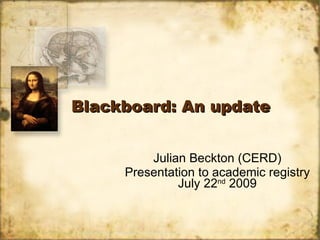Registry Bb
- 1. Blackboard: An update Julian Beckton (CERD) Presentation to academic registry July 22 nd 2009
- 2. Changes this year Mostly âback-endâ. Biggest user change is that gradebook is now âGrade Centreâ Subject sites will no longer âroll overâ
- 3. Blackboard Architecture 3 types of site populated by overnight âsnapshotâ of QLS. Module (e.g. ANI1001-0910) Award (e.g. BA Hons Animation ANIANII0910) Subject (Animation)
- 4. Implications for students Whatever a student is enrolled on in QLS will be reflected in Blackboard. BUT A site must be made available by teaching staff before students can see it
- 5. Roles Instructor Teaching Assistant Student
- 6. Common problems Student canât see site Not enrolled in QLS Site not made available â Manualâ enrolment can block students access. Staff canât see site Co-ordinators (or HoD) should have access and are responsible for enrolling correct instructors
- 7. QLS & Blackboard Blackboard totally dependent on QLS So problems should be fixed in QLS Changes made to QLS may cause problems for Blackboard
- 8. Help Helpsheets, FAQs and videos on Bb help tab [email_address] [email_address] CERD contacts Andy Hagyard x6034 Julian Beckton x 6758 Sue Watling x 6350
Editor's Notes
- #2: Who was here last year? Ask what they remember from Andyâs presentation. Unlike the Virtual Campus BB is a commercial product so occasionally gets software updates We are upgrading this year â from version 7.0 to version 8.0 so Iâll outline the changes there Also a slight change to the âArchitectureâ of Blackboard, and Iâll describe that. Finish by looking at some common problems, and suggest where you can get help.
- #3: So, version 7.0 to version 8 Most of the changes are âback-endâ that is improvements to the software to make it run more efficiently. These wonât affect anyone outside of Computing Services. From an academic users perspective the user interface to the gradebook has been dramatically improved. Itâs now called the âGrade Centreâ and works much more like an Excel spreadsheet. Tutors can simply enter marks in the appropriate cells, can re-order columns, and set the view to display only relevant assessments. There isnât actually much of an increase in functionality. â For example we donât yet have direct export to the Universityâs marks databases, although the spreadsheet can be exported to EXCEL, and, presumably imported from that. The other change weâre making is that subject sites will no longer roll over, that is new ones will no longer be created each year. (I see a few blank faces â let me remind you of BBâs architecture!)
- #4: Blackboard is made up of what we call âsitesâ. (You can think of them as course web sites if it helps.) You have to be enrolled in a site to see it. As you know the universityâs academic programme is constructed of âawardsâ which are made up of âmodulesâ. Most of the teaching takes place in âmodulesâ. So, Blackboard creates a site for every module listed in the QLS database, and populates it with a) the module co-ordinator, and b) all the students who are enrolled on that module for the current academic year. But when we introduced Blackboard, teaching staff said âYes, thatâs all very well, but we donât really teach like that. We want to be able to get materials to all students doing an âawardâ â e.g. all students doing a law degree. So we thought, OK â weâll get Blackboard to create âawardâ sites â and also while weâre at it, we might as well get it to create sites for each level of each award as well. So each award has four sites. One for the whole award, and one each for level 1, 2 and 3) Anyone see the problem? Yep. Joint awards. Because computers do what you tell them to do (not what you want them to do!) , a joint award is a completely different entity from a single honours. So there have to be four sites for every joint too! And of course a student who is doing a joint award in law and animation is not enrolled on either of the single honours awards, meaning that staff using award sites have to post material on a second site for those doing joints. So we created the âsubjectâ site. This is created from the modules and effectively means that every student doing any animation (or whatever) module at any level, is enrolled on that site. Now. Because a subject site is populated with live students, there is no point in creating a live site every year â any content would just have to be copied over to a new site. So any live student will also be able to see their subject site, provided it has been made available.
- #5: So a student doing BA hons Architecture, for example, would be enrolled on the subject site for architecture, the award site for BA hons architecture, the site for the level that they were on, and the sites for any modules. Which, you might think contained some potential for confusion. What a course team needs to do is consider which of these options that they want to make available to students. The vast majority of colleagues just use the module sites, and some of these also use the subject site, simply for making announcements to all students in their discipline. The big difference is in art and design, where subject sites are being used as the main course site. This brings me to another concept that you need to know about, that of the role. Roles are what determine what you can do in a site. We tend to use one three roles, although there are others, and we can create new ones. The three roles are âinstructorâ, âteaching assistantâ, and âstudentâ
- #6: Roles are at the root of most of the common problems you might run into. A user with the âinstructorâ role has, as far as the site is concerned, pretty much unlimited power in the site. Their name (or names) appears on the front page. They can enrol other users and allocate roles to them. In module sites, the module co-ordinator is automatically given this role, and the same is true of programme leaders in award sites. BUT this only happens if this information is listed in QLS. Where it isnât the head of department is usually substituted. Subject sites do not have an equivalent and unless somebody asks for them, they remain invisible. The second role, âteaching assistantâ is used for people like subject librarians and administrative staff. They have broadly similar powers to instructors except that their names do not appear on the front page. But they can post material, make announcements and so forth. The final role is of course âstudentâ. They can download material, or upload it to certain specified areas, and access all they need for learning but they can not enrol anyone else.
- #7: It sometimes happened that a student canât see a site. As it says on the slide there are a number of reasons why this might be the case. It could be that there has been some clerical error meaning that theyâre not properly enrolled. It might be that the teaching staff have made the wrong site available. (e.g. 08/09 instead of 09/10) or, possibly not realised that they need to make the site available. (It may also be the case that they have made it available, but have posted stuff on the wrong site!) In these kind of situations it is very tempting for users with instructor, or teaching assistant rights to manually enrol a student on to the site. Blackboard will not prevent them from doing so. But if the error is rectified in QLS, the next time the snapshot runs (i.e. that night!) Blackboard will identify a conflict and freeze the student account. We canât rectify this at our end, and we need to involve computing services to clear it. So the only time a student should be manually enrolled on any site is if they would like access to a module that they are not enrolled on. (e.g. as a taster session) If they like what they see and choose to sign up for that module, then their account should be removed from the Blackboard module before their details are upgraded on QLS. Staff are slightly different. As there is no QLS database of staff, instructors and teaching assistants can enrol colleagues and in fact we encourage them to do so. But â they must take care to give them the correct role. Only a system administrator can change a users role once it has been created.
- #8: So, remember that Blackboard is totally dependent on QLS for accurate population of student sites. Any problems with student registrations should be fixed in QLS, rather than in Blackboard. Even if Blackboard appears to allow you to fix the problem, youâre almost certainly storing up trouble for later. Also if youâre planning to make changes to data structures in QLS remember that this might well have implications for Blackboard. So if youâre in any doubt have a look at the sources of help weâve been providing.
- #9: Helpsheets are primarily designed for academic staff and students, but you may find them useful There is also a couple of useful e-mail addresses â the first is for general enquiries about blackboard, but the second is specifically designed for questions about student registration, and/or missing modules. Finally you could just give us a ring, or drop us an e-mail Thank you. Any questions?







![Help Helpsheets, FAQs and videos on Bb help tab [email_address] [email_address] CERD contacts Andy Hagyard x6034 Julian Beckton x 6758 Sue Watling x 6350](https://image.slidesharecdn.com/registrybb-124842683797-phpapp02/85/Registry-Bb-8-320.jpg)



























